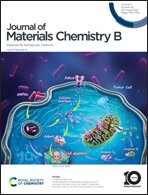A S-substituted Nile Blue-derived bifunctional near-infrared fluorescent probe for in vivo carboxylesterase imaging-guided photodynamic therapy of hepatocellular carcinoma†
Abstract
The development of theranostic probes that integrate both diagnostic and therapeutic functions still remains an intractable challenge in precise cancer treatment. Herein, a novel bifunctional near-infrared (NIR) fluorescent probe (CEP1) for carboxylesterase (CE) imaging and photodynamic therapy (PDT) of hepatocellular carcinoma (HCC) has been firstly developed and successfully applied in vitro and in vivo. The probe was constructed by introducing carbamate as both the recognition unit and the fluorescence quenching unit into the fluorophore S-substituted Nile Blue (ENBS) via a self-eliminating spacer with substituted chloride. It can be activated by CE and hydrolyzed into fluorescent ENBS, which recover fluorescence at about 700 nm, and can generate superoxide radical anions under NIR irradiation. Additionally, the probe could effectively distinguish tumor cells from normal cells by CE imaging of live cells. Furthermore, it could achieve CE imaging in vivo and significantly inhibits tumor growth by imaging-guided PDT. Therefore, this study offers a promising and attractive platform for activatable imaging-guided PDT of HCC.



 Please wait while we load your content...
Please wait while we load your content...